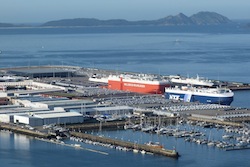 Following healthy annual figures for vehicle handling at the north-western Spanish port of Vigo, as reported last month, and the introduction of the Vigo-Nantes sea motorway service, the management authority at the port has been re-evaluating the existing layout, with a view to making operations more efficient.
Following healthy annual figures for vehicle handling at the north-western Spanish port of Vigo, as reported last month, and the introduction of the Vigo-Nantes sea motorway service, the management authority at the port has been re-evaluating the existing layout, with a view to making operations more efficient.
In total, €9m ($10.1m) is to be invested in upgrading Vigo's ro-ro facilities, of which half will be financed by the European Union (EU). Upgrading work is due to be completed by December this year.
The investment will go to establishing an exclusive area in the East Zone of Bouzas Terminal, which will be used by traffic generated by the sea motorway service operated by the SuardÌaz shipping line.
This could comprise either finished vehicles, built mainly by PSA Peugeot Citroën, or trailers carrying parts and components.
A tender for the construction of a new ro-ro ramp has already resulted in a €3.5m contract having been awarded. Again, the EU will pick up €640,000 of that bill.
In addition, on the eastern side of the terminal, an area is to be created to allow vessels to be moored, using four pilot structures. This will make it possible for ships of up to 200 metres in length to be handled there. The project, which has a budget of €4.8m, is expected to be put out to tender shortly.
The additional traffic that could be created by the enhanced Vigo-Nantes connection may well result in Vigo becoming a regional hub for ro-ro traffic.
Vehicle manufacturing plants in Spain wanting to export output to either the north of Europe or Africa may well be tempted to switch consignments to Vigo, while car carrying shipping lines could be persuaded to upgrade transshipment services at the port.
Citroën, Renault and Toyota already use the Bouzas terminal to export vehicles to Algeria, Egypt and Palestine.


























![Global[1]](https://d3n5uof8vony13.cloudfront.net/Pictures/web/a/d/s/global1_726550.svgz)









